Ciglitazone negatively regulates CXCL1 signaling through MITF to suppress melanoma growth
- PMID: 20596077
- PMCID: PMC3131866
- DOI: 10.1038/cdd.2010.75
Ciglitazone negatively regulates CXCL1 signaling through MITF to suppress melanoma growth
Abstract
We have previously demonstrated that the thiazolidinedione ciglitazone inhibited, independently of PPARγ activation, melanoma cell growth. Further investigations now show that ciglitazone effects are mediated through the regulation of secreted factors. Q-PCR screening of several genes involved in melanoma biology reveals that ciglitazone inhibits expression of the CXCL1 chemokine gene. CXCL1 is overexpressed in melanoma and contributes to tumorigenicity. We show that ciglitazone induces a diminution of CXCL1 level in different human melanoma cell lines. This effect is mediated by the downregulation of microphthalmia-associated transcription factor, MITF, the master gene in melanocyte differentiation and involved in melanoma development. Further, recombinant CXCL1 protein is sufficient to abrogate thiazolidinedione effects such as apoptosis induction, whereas extinction of the CXCL1 pathway mimics phenotypic changes observed in response to ciglitazone. Finally, inhibition of human melanoma tumor development in nude mice treated with ciglitazone is associated with a strong decrease in MITF and CXCL1 levels. Our results show that anti-melanoma effects of thiazolidinediones involve an inhibition of the MITF/CXCL1 axis and highlight the key role of this specific pathway in melanoma malignancy.
Figures
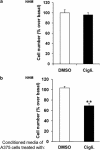
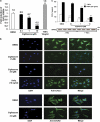

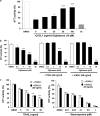
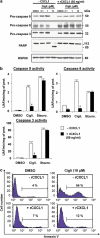


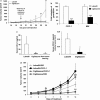
Similar articles
-
In vitro and in vivo anti-melanoma effects of ciglitazone.J Invest Dermatol. 2009 May;129(5):1208-18. doi: 10.1038/jid.2008.346. Epub 2009 Jan 29. J Invest Dermatol. 2009. PMID: 19177142
-
PPAR gamma regulates MITF and beta-catenin expression and promotes a differentiated phenotype in mouse melanoma S91.Pigment Cell Melanoma Res. 2008 Jun;21(3):388-96. doi: 10.1111/j.1755-148X.2008.00460.x. Epub 2008 Apr 26. Pigment Cell Melanoma Res. 2008. PMID: 18444964 Free PMC article.
-
PAX3 knockdown in metastatic melanoma cell lines does not reduce MITF expression.Melanoma Res. 2011 Feb;21(1):24-34. doi: 10.1097/CMR.0b013e328341c7e0. Melanoma Res. 2011. PMID: 21164369
-
The master role of microphthalmia-associated transcription factor in melanocyte and melanoma biology.Lab Invest. 2017 Jun;97(6):649-656. doi: 10.1038/labinvest.2017.9. Epub 2017 Mar 6. Lab Invest. 2017. PMID: 28263292 Review.
-
[Malignant melanoma and the role of the paradoxal protein Microphthalmia transcription factor].Bull Cancer. 2007 Jan;94(1):81-92. Bull Cancer. 2007. PMID: 17237008 Review. French.
Cited by
-
Whole genome expression profiling in chewing-tobacco-associated oral cancers: a pilot study.Med Oncol. 2015 Mar;32(3):60. doi: 10.1007/s12032-015-0483-4. Epub 2015 Feb 7. Med Oncol. 2015. PMID: 25663065
-
PPARs: Interference with Warburg' Effect and Clinical Anticancer Trials.PPAR Res. 2012;2012:304760. doi: 10.1155/2012/304760. Epub 2012 May 8. PPAR Res. 2012. PMID: 22654896 Free PMC article.
-
Homotypic cell cannibalism, a cell-death process regulated by the nuclear protein 1, opposes to metastasis in pancreatic cancer.EMBO Mol Med. 2012 Sep;4(9):964-79. doi: 10.1002/emmm.201201255. Epub 2012 Jul 23. EMBO Mol Med. 2012. PMID: 22821859 Free PMC article.
-
CXCL1: Gene, Promoter, Regulation of Expression, mRNA Stability, Regulation of Activity in the Intercellular Space.Int J Mol Sci. 2022 Jan 12;23(2):792. doi: 10.3390/ijms23020792. Int J Mol Sci. 2022. PMID: 35054978 Free PMC article. Review.
-
Metformin inhibits melanoma development through autophagy and apoptosis mechanisms.Cell Death Dis. 2011 Sep 1;2(9):e199. doi: 10.1038/cddis.2011.86. Cell Death Dis. 2011. PMID: 21881601 Free PMC article.
References
-
- Brose MS, Volpe P, Feldman M, Kumar M, Rishi I, Gerrero R, et al. BRAF and RAS mutations in human lung cancer and melanoma. Cancer Res. 2002;62:6997–7000. - PubMed
-
- Davies H, Bignell GR, Cox C, Stephens P, Edkins S, Clegg S, et al. Mutations of the BRAF gene in human cancer. Nature. 2002;417:949–954. - PubMed
-
- Demierre MF. Epidemiology and prevention of cutaneous melanoma. Curr Treat Options Oncol. 2006;7:181–186. - PubMed
Publication types
MeSH terms
Substances
LinkOut - more resources
Full Text Sources
Medical
Molecular Biology Databases

